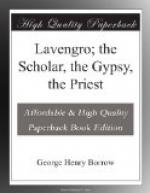One day, after a scene with the publisher similar to that which I have described above, I found myself about noon at the bottom of Oxford Street, where it forms a right angle with the road which leads or did lead to Tottenham Court. Happening to cast my eyes around, it suddenly occurred to me that something uncommon was expected; people were standing in groups on the pavement—the upstair windows of the houses were thronged with faces, especially those of women, and many of the shops were partly, and not a few entirely, closed. What could be the reason of all this? All at once I bethought me that this street of Oxford was no other than the far-famed Tyburn way. Oh, oh, thought I, an execution; some handsome young robber is about to be executed at the farther end; just so, see how earnestly the women are peering; perhaps another Harry Simms—Gentleman Harry as they called him—is about to be carted along this street to Tyburn tree; but then I remembered that Tyburn tree had long since been cut down, and that criminals, whether young or old, good-looking or ugly, were executed before the big stone gaol, which I had looked at with a kind of shudder during my short rambles in the City. What could be the matter? just then I heard various voices cry, ’There it comes!’ and all heads were turned up Oxford Street, down which a hearse was slowly coming: nearer and nearer it drew; presently it was just opposite the place where I was standing, when, turning to the left, it proceeded slowly along Tottenham Road; immediately behind the hearse were three or four mourning coaches, full of people, some of whom, from the partial glimpse which I caught of them, appeared to be foreigners; behind these came a very long train of splendid carriages, all of which, without one exception, were empty.
‘Whose body is in that hearse?’ said I to a dapper-looking individual, seemingly a shopkeeper, who stood beside me on the pavement, looking at the procession.
‘The mortal relics of Lord Byron,’ said the dapper-looking individual, mouthing his words and smirking—’the illustrious poet, which have been just brought from Greece, and are being conveyed to the family vault in —–shire.’
‘An illustrious poet, was he?’ said I.
‘Beyond all criticism,’ said the dapper man; ’all we of the rising generation are under incalculable obligation to Byron; I myself, in particular, have reason to say so; in all my correspondence my style is formed on the Byronic model.’
I looked at the individual for a moment, who smiled and smirked to himself applause, and then I turned my eyes upon the hearse proceeding slowly up the almost endless street. This man, this Byron, had for many years past been the demigod of England, and his verses the daily food of those who read, from the peer to the draper’s assistant; all were admirers, or rather worshippers, of Byron, and all doated on his verses; and then I thought of those who, with




